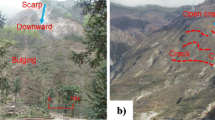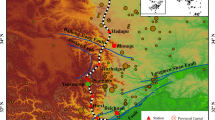Abstract
In order to study the seismic response of the embankment slopes with different reinforcing measures, shaking table tests were performed on three embankment slope models (i.e., unreinforced embankment slope, 2-layer reinforced embankment slope and 4-layer reinforced embankment slope). Wenchuan earthquake motions and white noise excitations were performed to investigate the change of the model parameters, the horizontal acceleration response, the vertical acceleration response and the dynamic earth pressure response of embankment slopes. A comparison was made on the seismic response among the embankment slopes with different reinforcing measures. The results show that the natural frequency of reinforced embankment slope is larger than that of unreinforced embankment slope, and the reinforced embankment slope is less sensitive to seismic excitation. Horizontal acceleration response is obviously amplified by embankment slope. Horizontal acceleration magnification presents a decreasing trend with the increase of the peak value of input horizontal acceleration, and the decreasing ratio is higher for reinforced embankment slope. The vertical acceleration magnification of reinforced embankment slope is much smaller than that of unreinforced embankment slope, and the nonlinear characteristic of embankment slope in vertical direction is not as obvious as that in horizontal direction. Residual earth pressure is mainly induced at the upper part of embankment slope.













Similar content being viewed by others
References
Alavi B, Krawinkler H (2004) Behaviour of moment resisting frame structures subjected to near-fault ground motions. Earthq Eng Struct Dyn 33(6):687–706
Bakir BS, Akis E (2005) Analysis of a highway embankment failure associated with the 1999 Duzce Turkey earthquake. Soil Dyn Earthq Eng 25(3):251–260
Chopra AK, Chintanapakdee C (2001a) Comparing response of SDF systems to near-fault and far-fault earthquake motions in the context of spectral regions. Earthq Eng Struct Dyn 30(12):1769–1789
Chopra AK, Chintanapakdee C (2001b) Drift spectrum versus modal analysis of structural response to near-fault ground motions. Earthq Spectra 17(2):221–234
Chugh AK (1995) Dynamic displacement analysis of embankment dams. Geotechnique 45(2):295–299
Crespellani T, Facciorusso J, Madiai C, Vannucchi G (2003) Influence of uncorrected accelerogram processing techniques on Newmark’s rigid block displacement evaluation. Soil Dyn Earthq Eng 23(6):415–424
Davoodi M, Jafari MK, Hadiani N (2013) Seismic response of embankment dams under near-fault and far-field ground motion excitation. Eng Geol 158:66–76
Ha JG, Lee SH, Kim DS, Choo YW (2014) Simulation of soil-foundation-structure interaction of Hualien large-scale seismic test using dynamic centrifuge test. Soil Dyn Earthq Eng 61(62):176–187
Hong YS, Chen RH, Wu CS, Chen JR (2005) Shaking table tests and stability analysis of steep nailed slopes. Can Geotech J 42(5):1264–1279
Hsieh SY, Lee CT (2011) Empirical estimation of the Newmark displacement from the Arias intensity and critical acceleration. Eng Geol 122(1–2):34–42
Huang Y, Jiang XM (2010) Field-observed phenomena of seismic liquefaction and subsidence during the 2008 Wenchuan earthquake in China. Nat Hazards 54(3):839–850
Huang Y, Sawada K, Moriguchi S, Yashima A, Zhang F (2006) Numerical assessment of the effect of reinforcement on the performance of reinforced soil dikes. Geotext Geomembr 24(3):169–174
Huang Y, Zhang WJ, Mao WW, Jin C (2011) Flow analysis of liquefied soils based on smoothed particle hydrodynamics. Nat Hazards 59(3):1547–1560
Huang Y, Zhang WJ, Xu Q, Xie P, Hao L (2012a) Run-out analysis of flow-like landslides triggered by the Ms 8.0 2008 Wenchuan earthquake using smoothed particle hydrodynamics. Landslides 9(2):275–283
Huang Y, Zheng H, Zhuang ZJ (2012b) Seismic liquefaction analysis of a reservoir dam foundation in the South-North Water Diversion project in China. Part I: liquefaction potential assessment. Nat Hazards 60(3):1299–1311
Huang Y, Zheng H, Zhuang ZJ (2012c) Seismic liquefaction analysis of a reservoir dam foundation in the South-North Water Diversion project in China. Part II: seismic response simulation. Nat Hazards 60(3):1313–1324
Huang RQ, Zhao JJ, Ju NP (2013) Analysis of an anti-dip landslide triggered by the 2008 Wenchuan earthquake in China. Nat Hazards 68(2):1021–1039
Iai S (1989) Similitude for shaking table tests on soil-structure fluid model in 1-g gravitational field. Soils Found 29(1):105–118
Jibson RW (2011) Methods for assessing the stability of slopes during earthquakes-A retrospective. Eng Geol 122(1–2):43–50
Kagawa T, Sato M, Minowa C, Abe A, Tazoh T (2004) Centrifuge simulations of large-scale shaking table tests: case studies. J Geotech Geoenviron Eng 130(7):663–672
Kamai T, Sangawa A (2011) Landslides on ancient embankments in the Kinki district (Japan): strong motion seismoscope of the 1596 Keichou-Fushimi earthquake. Quaternary Int 242(1):90–105
Kim JM, Sitar N (2013) Probabilistic evaluation of seismically induced permanent deformation of slopes. Soil Dyn Earthq Eng 44:67–77
Lin YL (2013a) Deformation behavior of reinforced embankment slopes under seismic excitation. Disaster Adv 6(7):12–19
Lin YL (2013b) Shaking table modeling of embankment slope response to earthquake loading. Disaster Adv 6(12):69–77
Lin ML, Wang KL (2006) Seismic slope behavior in a large-scale shaking table model test. Eng Geol 86(2):118–133
Lin YL, Yang GL (2013) Dynamic behavior of railway embankment slope subjected to seismic excitation. Nat Hazards 69(1):219–235
Liu RS, Shi HB (2006) An improved pseudo-static method for seismic resistant design of underground structures. Earthq Eng Eng Vib 5(2):189–193
Liu CN, Yang KH, Ho YH, Chang CM (2012) Lessons learned from three failures on a high steep geogrid-reinforced slope. Geotext Geomembr 34:131–143
Liu J, Liu FH, Kong XJ, Yu L (2014) Large-scale shaking table model tests of aseismic measures for concrete faced rock-fill dams. Soil Dyn Earthq Eng 61(62):152–163
Mohajeri M, Towhata I (2003) Shake table tests on residual deformation of sandy slopes due to cyclic loading. Soils Found 43(6):91–106
Motamed R, Towhata I, Honda T, Tabata K, Abe A (2013) Pile group response to liquefaction-induced lateral spreading: E-Defense large shake table test. Soil Dyn Earthq Eng 51:35–46
Munwar B, Sivakumar B (2009) Earthquake resistant design of reinforced soil structures using pseudo static method. Am J Eng Appl Sci 2(3):565–572
Newmark NM (1965) Effects of earthquakes on dams and embankments. Geotechnique 15:139–159
Omer A, Resat U (2002) Back-analysis of a seismically induced highway embankment failure during the 1999 Duzce earthquake. Environ Geol 42(6):621–631
Rayhani MHT, El Naggar MH (2007) Centrifuge modeling of seismic response of layered soft clay. Bull Earthq Eng 5(4):571–589
Sandri D (1997) A performance summary of reinforced soil structures in the greater Los Angeles area after the Northridge earthquake. Geotext Geomembr 15(4–6):235–253
Shukha R, Baker R (2008) Design implications of the vertical pseudo-static coefficient in slope analysis. Comput Geotech 35(1):86–96
Singh R, Roy D, Jain SK (2005) Analysis of earth dams affected by the 2001 Bhuj Earthquake. Eng Geol 80(3–4):282–291
Srilatha N, Latha MG, Puttappa CG (2013) Effect of frequency on seismic response of reinforced soil slopes in shaking table tests. Geotext Geomembr 36:27–32
Tatsuoka F, Tateyama M, Matsushima K (2007) Remedial treatment of soil structures using geosynthetic-reinforcing technology. Geotext Geomembr 25(4–5):204–220
Teymur B, Madabhushi SPG (2003) Experimental study of boundary effects in dynamic centrifuge modeling. Geotechnique 53(7):655–663
Torisu SS, Sato J, Towhata I, Honda T (2010) 1-G model tests and hollow cylindrical torsional shear experiments on seismic residual displacements of fill dams from the viewpoint of seismic performance-based design. Soil Dyn Earthq Eng 30(6):423–437
Toyohiko M, Daisuke H, Hiroshi Y, Shoji D, Noriyuki C, Jun U, Go S (2011) Reconnaissance report on landslide disasters in northeast Japan following the M 9 Tohoku earthquake. Landslides 8(3):339–342
Turan A, Hinchberger SD, El Naggar MH (2013) Seismic soil-structure interaction in buildings on stiff clay with embedded basement stories. Can Geotech J 50(8):858–873
Wang JA, Yao LK, Hussain A (2010) Analysis of earthquake-triggered failure mechanisms of slopes and sliding surfaces. J Mt Sci-Engl 7(3):282–290
Wang LP, Zhang G, Zhang JM (2011) Centrifuge model tests of geotextile-reinforced soil embankments during an earthquake. Geotext Geomembr 29(3):222–232
Xu C, Xu XW (2013) Controlling parameter analyses and hazard mapping for earthquake-triggered landslides: an example from a square region in Beichuan County, Sichuan Province China. Arab J Geosci 6(10):3827–3839
Xu C, Shyu JBH, Xu XW (2014a) Landslides triggered by the 12 January 2010 Port-au-Prince, Haiti, Mw = 7.0 earthquake: visual interpretation, inventory compiling, and spatial distribution statistical analysis. Nat Hazards Earth Sys 14(7):1789–1818
Xu C, Xu XW (2014) Statistical analysis of landslides caused by the Mw 6.9 Yushu, China, earthquake of April 14, 2010. Nat Hazards 72(2):871–893
Xu C, Xu XW, Shyu JBH, Zheng WJ, Min W (2014b) Landslides triggered by the 22 July 2013 Minxian–Zhangxian, China, Mw 5.9 earthquake: inventory compiling and spatial distribution analysis. J Asian Earth Sci 92:125–142
Xu C, Xu XW, Yao X, Dai FC (2014c) Three (nearly) complete inventories of landslides triggered by the May 12, 2008 Wenchuan Mw 7.9 earthquake of China and their spatial distribution statistical analysis. Landslides 11(3):441–461
Yaghmaei-Sabegha S, Tsang HH (2011) An updated study on near-fault ground motions of the 1978 Tabas, Iran, earthquake (Mw = 7.4). Sci. Iran 18(4):895–905
Yu YZ, Deng LJ, Sun X, Lu H (2008) Centrifuge modeling of a dry sandy slope response to earthquake loading. Bull Earthq Eng 6(3):47–461
Yu YZ, Deng LJ, Sun X, Lu H (2010) Centrifuge modeling of dynamic behavior of pile-reinforced slopes during earthquakes. J Cent South Univ Technol 17(5):1070–1078
Acknowledgments
This work is financially supported by the National Natural Science Foundation of China (51308551), the China Postdoctoral Science Foundation Funded Project (2012M511760), the Hunan Provincial Natural Science Foundation of China (13JJ4017) and the Fundamental Research Funds for the Central Universities of China (2012QNZT051).
Author information
Authors and Affiliations
Corresponding author
Rights and permissions
About this article
Cite this article
Lin, Yl., Leng, Wm., Yang, Gl. et al. Seismic response of embankment slopes with different reinforcing measures in shaking table tests. Nat Hazards 76, 791–810 (2015). https://doi.org/10.1007/s11069-014-1517-5
Received:
Accepted:
Published:
Issue Date:
DOI: https://doi.org/10.1007/s11069-014-1517-5




